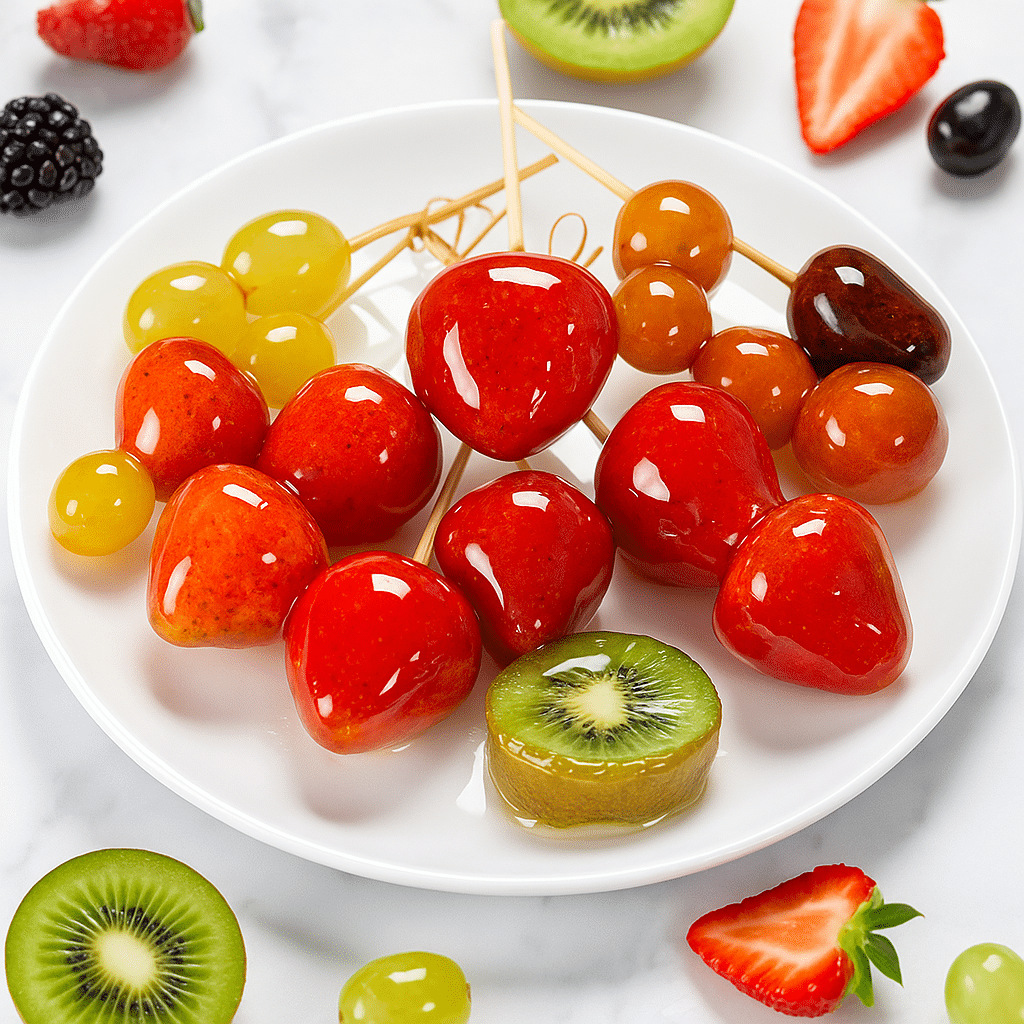Welcome to CrennRecipes! I’m Chef Crenn, passionate about food, creativity, and community. I’ve crafted culinary delights for over a decade, blending traditional techniques with modern creativity. My love for cooking started in my grandmother’s kitchen, learning fresh ingredients and flavor magic. I’ve honed skills in top kitchens through countless experimentation. Cooking is art, science, and connection. My recipes inspire confidence, encourage experimentation, and bring people together through food joy. Every dish tells a story.
Follow our journey and discover more recipe inspirations on Facebook where we share daily cooking tips and behind-the-scenes content.
Tanghulu candied fruit represents one of China’s most beloved street food traditions, transforming ordinary fruit into extraordinary crystalline treats that capture hearts worldwide. Furthermore, this ancient confection combines the natural sweetness of fresh fruit with a perfectly crisp sugar coating, creating an irresistible contrast of textures. Additionally, mastering tanghulu at home opens doors to endless creative possibilities, allowing you to experiment with various fruits and flavoring techniques.
Discovering the Magic Behind Perfect Tanghulu Candied Fruit Technique
Understanding Traditional Chinese Candy-Making Methods
Tanghulu candied fruit originated during China’s Song Dynasty, evolving from simple medicinal preparations into beloved street treats. Moreover, traditional vendors perfected techniques passed down through generations, creating the signature glass-like coating that defines authentic tanghulu. Similarly, modern home cooks can achieve professional results by understanding fundamental temperature control and timing principles.
The secret lies in reaching the precise hard crack stage, typically around 300°F (150°C), where sugar transforms into a crystal-clear coating. Furthermore, this temperature creates the characteristic snap when you bite through the shell, revealing juicy fruit beneath. Additionally, working quickly becomes essential since the sugar mixture hardens rapidly once removed from heat.
Traditional Chinese candy makers often use hawthorn berries, known for their tartness that balances the sweet coating beautifully. However, contemporary adaptations embrace various fruits, including strawberries, grapes, and kiwi slices. Meanwhile, understanding fruit selection principles ensures success, as firmer fruits with natural acidity work best for tanghulu candied fruit preparations.
Professional techniques involve using wooden skewers to create easy-to-eat portions while maintaining temperature consistency throughout the coating process. Additionally, experienced makers prepare ice baths beforehand, allowing immediate cooling that sets the sugar shell perfectly. Furthermore, proper timing prevents the coating from becoming too thick or developing unwanted crystallization patterns.
The artistry extends beyond mere technique, encompassing presentation traditions that make tanghulu candied fruit visually stunning. Moreover, color combinations and arrangement patterns reflect regional preferences and seasonal availability. Similarly, understanding these cultural elements enhances appreciation for this time-honored confection while inspiring creative variations that honor traditional methods.
Mastering Temperature Control for Flawless Sugar Coating
Temperature control represents the most critical aspect of creating perfect tanghulu candied fruit, requiring precision and attention to detail. Furthermore, achieving the hard crack stage consistently produces that signature crispy shell that distinguishes authentic tanghulu from ordinary candy-coated fruit. Additionally, understanding sugar stages empowers home cooks to troubleshoot common problems and achieve professional-quality results.
Digital thermometers provide the most reliable temperature readings, eliminating guesswork from the candy-making process. However, experienced cooks also learn to recognize visual cues, such as the color changes and bubble patterns that indicate proper temperature ranges. Meanwhile, the cold water test offers a backup method, where drops of syrup form brittle threads when ready.
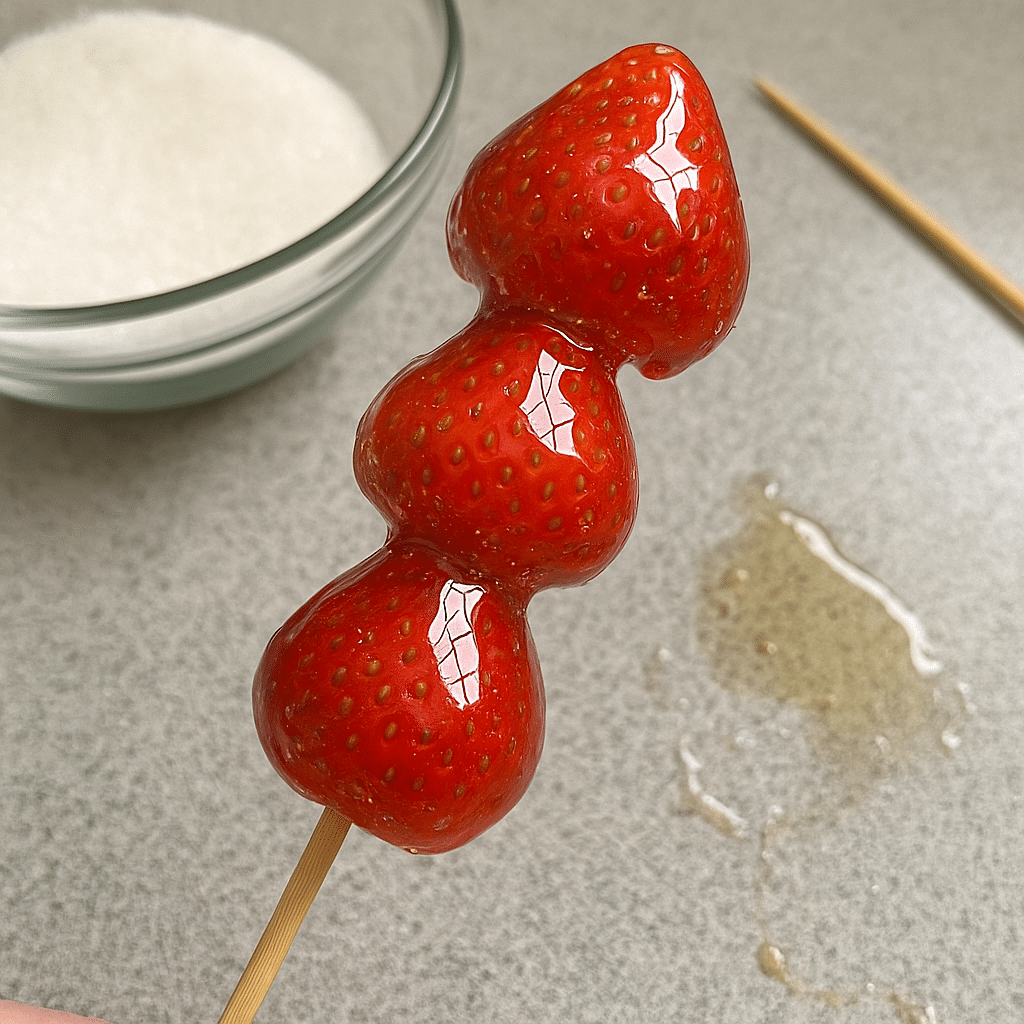
Maintaining consistent heat throughout the cooking process prevents sugar from burning or developing unwanted flavors. Furthermore, medium heat allows better control than high temperatures, giving cooks time to react to changes. Additionally, stirring disrupts crystallization, so avoiding agitation once boiling begins ensures smooth, clear coatings.
Professional-quality tanghulu candied fruit requires understanding how humidity affects sugar behavior, particularly in different climates. Moreover, dry conditions produce better results than humid environments, where moisture can interfere with proper crystallization. Similarly, timing becomes more critical on humid days, necessitating faster work speeds and potentially adjusted temperatures.
Advanced techniques include adding corn syrup or cream of tartar to improve texture and prevent unwanted crystallization. Furthermore, these ingredients help maintain the desired clarity while extending working time slightly. Additionally, understanding these modifications allows for consistent results regardless of weather conditions or ingredient variations.
Storage considerations also impact technique, as proper cooling and handling preserve the delicate sugar shell. Moreover, immediate consumption provides the best experience, though short-term storage in dry conditions remains possible. Meanwhile, learning these professional tips transforms occasional successes into consistently perfect tanghulu candied fruit that rivals commercial preparations.
Essential Ingredients and Equipment for Homemade Tanghulu Success
Selecting the Perfect Fruits for Your Tanghulu Creation
Choosing appropriate fruits forms the foundation of exceptional tanghulu candied fruit, directly impacting both flavor and structural integrity. Furthermore, understanding fruit characteristics helps predict how different varieties will behave during the coating process. Additionally, seasonal selection ensures peak flavors while maintaining cost-effectiveness for regular preparation.
Strawberries remain the most popular choice for tanghulu candied fruit, offering ideal size, sweetness, and visual appeal. Moreover, their natural tartness provides excellent balance against the sweet sugar coating, creating complex flavor profiles. Similarly, firm berries hold their shape better during coating, preventing messy outcomes that can discourage beginners.
Grapes offer another excellent option, particularly when using varieties with thicker skins that resist bursting during preparation. Furthermore, both red and green grapes work well, allowing for attractive color combinations when presenting mixed fruit tanghulu. Additionally, seedless varieties simplify eating while maintaining the satisfying contrast between crisp coating and juicy interior.
Kiwi slices create visually stunning tanghulu candied fruit with their vibrant green color and unique texture. However, proper preparation requires removing excess moisture and cutting to optimal thickness for even coating. Meanwhile, the tartness of kiwi complements the sweet shell beautifully, much like our watermelon feta summer salad balances sweet and tangy flavors.
Cherry tomatoes might seem unconventional, but they create surprisingly delicious tanghulu candied fruit with their firm texture and balanced acidity. Furthermore, their uniform size makes for consistent coating thickness and professional presentation. Additionally, experimenting with unusual fruits often leads to exciting discoveries, similar to how our sushi pizza combines unexpected elements successfully.
Advanced fruit selection considers moisture content, acidity levels, and structural integrity to predict coating adhesion and final texture. Moreover, combining multiple fruit types on single skewers creates visually appealing presentations while offering varied taste experiences. Similarly, understanding these principles allows for creative adaptations that honor traditional tanghulu while exploring modern flavor combinations.
For more creative fruit combination ideas and seasonal inspiration, check out our Pinterest boards featuring hundreds of tested recipes.
Essential Tools and Equipment for Professional Results
Proper equipment ensures consistent results when making tanghulu candied fruit, eliminating common frustrations that plague amateur attempts. Furthermore, investing in quality tools pays dividends through improved success rates and enhanced safety during high-temperature sugar work. Additionally, understanding each tool’s purpose helps optimize technique and achieve professional-quality outcomes.
Digital candy thermometers provide precise temperature readings essential for perfect sugar coating consistency. Moreover, probe-style thermometers with adjustable clips allow continuous monitoring without interfering with cooking processes. Similarly, backup thermometers offer peace of mind, particularly when attempting tanghulu candied fruit for special occasions or large batches.
Heavy-bottomed saucepans distribute heat evenly, preventing hot spots that can burn sugar before reaching proper temperature. Furthermore, medium-sized pans provide adequate depth for safe dipping while maintaining manageable volumes for home cooking. Additionally, stainless steel or enameled surfaces resist sticking and clean easily after use.
Wooden skewers create traditional presentations while providing safe handling for hot-coated fruit. However, metal skewers conduct heat, potentially making handling uncomfortable during the coating process. Meanwhile, selecting appropriate skewer lengths ensures easy dipping while maintaining comfortable grip distances from hot sugar.
Ice baths prepared in advance allow immediate cooling that sets sugar coatings properly. Furthermore, using large bowls with plenty of ice ensures adequate cooling capacity for multiple fruit pieces. Additionally, having towels nearby helps manage water splashing and provides clean work surfaces throughout the process.
Wire cooling racks covered with parchment paper create ideal surfaces for final cooling and presentation. Moreover, elevating coated fruit allows air circulation that promotes even cooling and prevents sticking. Similarly, preparation of all equipment before beginning ensures smooth workflow, much like the organized approach needed for our crispy air fryer french fries preparation.
Professional setups include dedicated candy-making spaces with adequate ventilation and easy cleanup capabilities. Furthermore, understanding workspace requirements prevents accidents and improves efficiency during time-sensitive coating processes. Additionally, proper organization transforms tanghulu candied fruit making from stressful endeavors into enjoyable culinary experiences.
Step-by-Step Instructions for Creating Restaurant-Quality Tanghulu
Preparing Your Fruit and Setting Up Your Workspace
Proper preparation forms the cornerstone of successful tanghulu candied fruit, requiring attention to detail and systematic organization. Furthermore, establishing efficient workflows prevents common mistakes that occur during high-pressure sugar coating phases. Additionally, understanding preparation principles ensures consistent results regardless of batch size or fruit variety.
Begin by thoroughly washing all fruits under cold running water, removing any surface contaminants that might affect coating adhesion. Moreover, gentle handling preserves fruit integrity while ensuring cleanliness standards appropriate for candy-making. Similarly, patting fruits completely dry with paper towels eliminates excess moisture that can interfere with sugar coating processes.
Strawberry preparation involves removing green tops carefully to maintain attractive shapes while creating stable surfaces for skewering. Furthermore, selecting uniformly sized berries ensures even coating thickness and professional presentation. Additionally, inspecting each berry for soft spots or damage prevents disappointing results in finished products.
Skewering techniques require inserting implements firmly enough to secure fruit without causing damage that releases juices. Moreover, positioning fruit at skewer ends allows maximum coating coverage while maintaining safe handling distances. Meanwhile, preparing all skewers before beginning sugar work prevents rushed assembly during time-critical phases.
Workspace organization includes arranging all equipment within easy reach while maintaining clear pathways for safe movement. Furthermore, preparing ice baths, cooling racks, and cleaning materials beforehand prevents delays that can ruin sugar coating consistency. Additionally, covering nearby surfaces with parchment paper simplifies cleanup and prevents accidental spills from causing damage.
Temperature considerations extend beyond sugar preparation to ambient conditions that affect working time and coating quality. Moreover, avoiding humid conditions whenever possible improves success rates significantly. Similarly, understanding environmental factors helps predict necessary adjustments, much like considering conditions when preparing our air fryer banana chips for optimal crispness.
Professional preparation includes timing considerations that coordinate fruit readiness with sugar preparation phases. Furthermore, understanding these sequences prevents fruit from deteriorating while sugar reaches proper temperature. Additionally, systematic approaches transform complex processes into manageable steps that build confidence and ensure success.
The Critical Sugar Cooking and Coating Process
The sugar cooking phase represents the most technical aspect of tanghulu candied fruit preparation, demanding precise timing and temperature control. Furthermore, understanding this process transforms mysterious candy-making into predictable science that produces consistent results. Additionally, mastering these techniques opens doors to advanced variations and creative adaptations.
Combine sugar and water in prepared saucepan, stirring gently until sugar dissolves completely before applying heat. Moreover, avoiding undissolved crystals prevents unwanted seeding that can ruin entire batches. Similarly, starting with room temperature water ensures even dissolution and smoother cooking processes.
Heat mixture over medium flame, resisting temptation to stir once boiling begins, as agitation promotes unwanted crystallization. Furthermore, monitoring temperature steadily prevents overheating that creates bitter flavors or burned sugar. Additionally, maintaining consistent heat levels ensures predictable timing and optimal working conditions.
Visual cues supplement temperature readings, with proper syrup displaying pale amber coloration and vigorous bubbling patterns. Moreover, experienced cooks learn to recognize subtle changes that indicate approaching readiness. Meanwhile, the cold water test provides backup confirmation when drops form brittle threads that snap cleanly.
Once target temperature is reached, immediately remove pan from heat and work quickly to coat prepared fruit. Furthermore, tilting pan slightly creates deeper pools that facilitate easier dipping without waste. Additionally, maintaining calm efficiency prevents accidents while ensuring thorough coating coverage.
Dipping technique involves smooth, confident movements that coat fruit evenly without creating drips or uneven thickness. Moreover, brief ice bath immersion sets coating immediately while preserving desired texture. Similarly, transferring to cooling racks allows proper air circulation, much like the careful timing needed for our churros poppers to achieve perfect texture.

Advanced coating techniques include double-dipping for thicker shells or flavor layering with different sugar preparations. Furthermore, understanding these variations allows customization for different preferences and occasions. Additionally, practice with basic techniques builds confidence for exploring creative adaptations that honor traditional tanghulu candied fruit while expressing personal culinary style.
Troubleshooting Common Problems and Creative Variations
Solving Tanghulu Texture and Coating Issues
Understanding common problems helps prevent frustration while building expertise in tanghulu candied fruit preparation. Furthermore, recognizing symptoms early allows corrective action before entire batches become unsalvageable. Additionally, troubleshooting knowledge transforms setbacks into learning opportunities that improve future results.
Coating that fails to harden properly typically indicates insufficient temperature, requiring longer cooking times to reach proper hard crack stage. Moreover, humidity can interfere with setting, necessitating extended cooling periods or controlled environment adjustments. Similarly, under-cooked sugar produces chewy textures instead of desired crispy shells.
Thick, cloudy coatings often result from crystallization caused by stirring during cooking or temperature fluctuations. Furthermore, adding small amounts of corn syrup or lemon juice can prevent this issue in future batches. Additionally, maintaining steady heat and avoiding agitation produces crystal-clear coatings that showcase fruit beautifully.
Uneven coating distribution usually stems from improper dipping technique or inadequate sugar depth in cooking vessel. Moreover, working too slowly allows sugar to thicken, creating lumpy applications. Meanwhile, practicing smooth, confident movements with room temperature fruit improves coating consistency significantly.
Fruit releasing excessive juices can dilute sugar coating or prevent proper adhesion, particularly with overripe specimens. Furthermore, proper fruit selection and preparation minimize this issue, while understanding timing helps identify optimal ripeness levels. Additionally, blotting excess moisture immediately before coating improves adhesion rates.
Coating that cracks or falls off indicates temperature problems or contamination from moisture or oils. Moreover, ensuring completely clean, dry fruit surfaces prevents most adhesion issues. Similarly, proper cooling techniques prevent thermal shock that can cause coating failure, much like the careful temperature control needed for our paula deens 5 minute fudge success.
Advanced troubleshooting considers environmental factors, ingredient quality, and equipment condition that affect consistent results. Furthermore, maintaining detailed notes helps identify patterns and improve future success rates. Additionally, understanding these variables builds expertise that enables reliable tanghulu candied fruit production regardless of conditions.
Creative Flavor Variations and Modern Adaptations
Exploring flavor variations expands tanghulu candied fruit beyond traditional preparations while honoring cultural origins. Furthermore, understanding basic principles enables creative experimentation that produces exciting new combinations. Additionally, modern adaptations can incorporate contemporary flavors while maintaining authentic texture and presentation qualities.
Share your tanghulu experiments and get feedback from fellow home cooks in our active Facebook community group where members exchange tips and variations.
Flavored sugar syrups create unique taste experiences by incorporating extracts, spices, or natural flavorings during cooking phases. Moreover, vanilla, almond, or citrus extracts add subtle complexity without overwhelming fruit flavors. Similarly, spices like cinnamon or ginger provide warming notes that complement seasonal fruit selections.
Colored coatings using natural food coloring create visually stunning presentations perfect for special occasions or themed events. Furthermore, understanding color theory helps create attractive combinations that enhance rather than mask natural fruit beauty. Additionally, multiple colored batches allow artistic arrangements that rival professional confections.
Chocolate-drizzled tanghulu combines Eastern and Western confectionery traditions, creating fusion treats that appeal to diverse palates. Moreover, timing chocolate application after coating sets ensures proper adhesion and attractive presentations. Meanwhile, white, milk, or dark chocolate varieties offer different flavor profiles and visual effects.
Nuts or seeds pressed into warm coatings add textural interest and nutritional value while creating gourmet presentations. Furthermore, chopped almonds, sesame seeds, or coconut flakes complement fruit flavors beautifully. Additionally, understanding timing ensures proper adhesion without compromising coating integrity.
Alcohol-infused syrups create sophisticated adult versions using small amounts of liqueurs or wines during cooking phases. Moreover, these additions require temperature adjustments to account for alcohol evaporation rates. Similarly, understanding these modifications allows creation of elegant desserts suitable for formal entertaining, much like the sophisticated flavors in our grilled peach sundae recipes.
Modern presentation techniques include arrangement patterns, serving vessels, and garnishing methods that elevate simple tanghulu candied fruit into restaurant-quality desserts. Furthermore, understanding these principles enables creative expression while maintaining traditional appeal. Additionally, combining classic techniques with contemporary aesthetics creates memorable culinary experiences that honor tradition while embracing innovation.
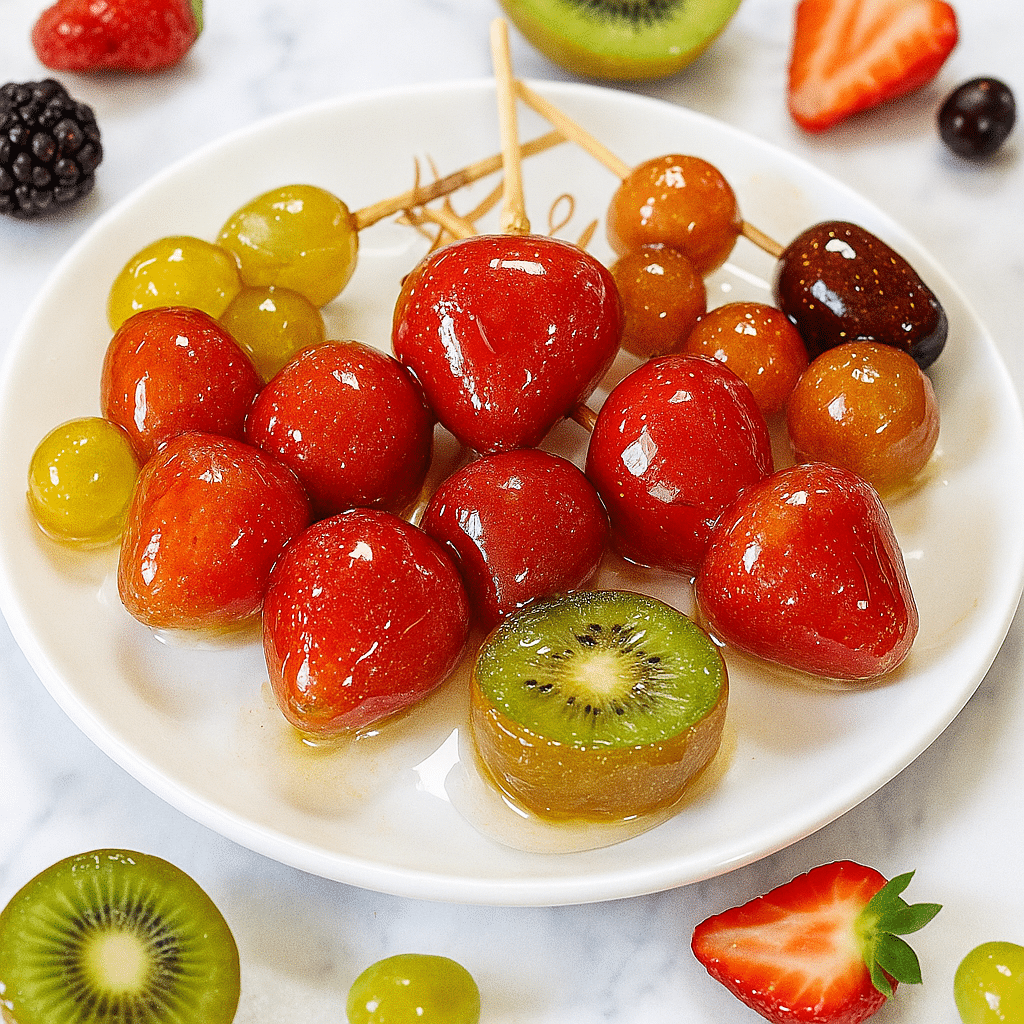
Frequently Asked Questions About Tanghulu Candied Fruit
What is the difference between candied fruit and tanghulu?
Tanghulu candied fruit differs significantly from traditional candied fruit in preparation method and final texture. Furthermore, tanghulu involves coating fresh fruit with hard sugar syrup that creates a crispy shell, while candied fruit typically involves cooking fruit in sugar solutions until preserved. Additionally, tanghulu maintains the fresh fruit’s natural texture and moisture, whereas candied fruit becomes uniformly sweet and chewy throughout.
What fruit is tanghulu made of?
Traditional tanghulu candied fruit uses hawthorn berries, but modern versions embrace various fruits including strawberries, grapes, kiwi slices, cherry tomatoes, and apple pieces. Moreover, successful fruits share characteristics like firm texture, natural acidity, and moderate moisture content. Similarly, the best choices balance sweetness with tartness, creating perfect contrast against the sugar coating.
Do you mix sugar and water when making tanghulu?
Yes, tanghulu candied fruit requires mixing sugar and water in a 2:1 ratio, cooking the mixture to hard crack stage around 300°F (150°C). Furthermore, this creates the signature glass-like coating that hardens immediately upon cooling. Additionally, avoiding stirring once boiling begins prevents crystallization that would create cloudy, grainy textures instead of clear, smooth coatings.
Why is my tanghulu not hardening?
Tanghulu that won’t harden typically indicates insufficient cooking temperature, high humidity conditions, or contamination from moisture. Moreover, ensuring your sugar syrup reaches proper hard crack stage around 300°F resolves most hardening issues. Additionally, working in dry conditions and using completely dried fruit improves success rates significantly, while ice baths help set coatings immediately after application.
Creating perfect tanghulu candied fruit transforms simple ingredients into extraordinary treats that celebrate both tradition and creativity. Furthermore, mastering these techniques opens doors to endless variations while building valuable candy-making skills. Additionally, understanding the science behind sugar work enables consistent success and confidence for future culinary adventures. Whether serving our protein pancakes for breakfast or tanghulu for dessert, achieving perfection requires patience, practice, and attention to detail that ultimately rewards dedicated effort with memorable results.
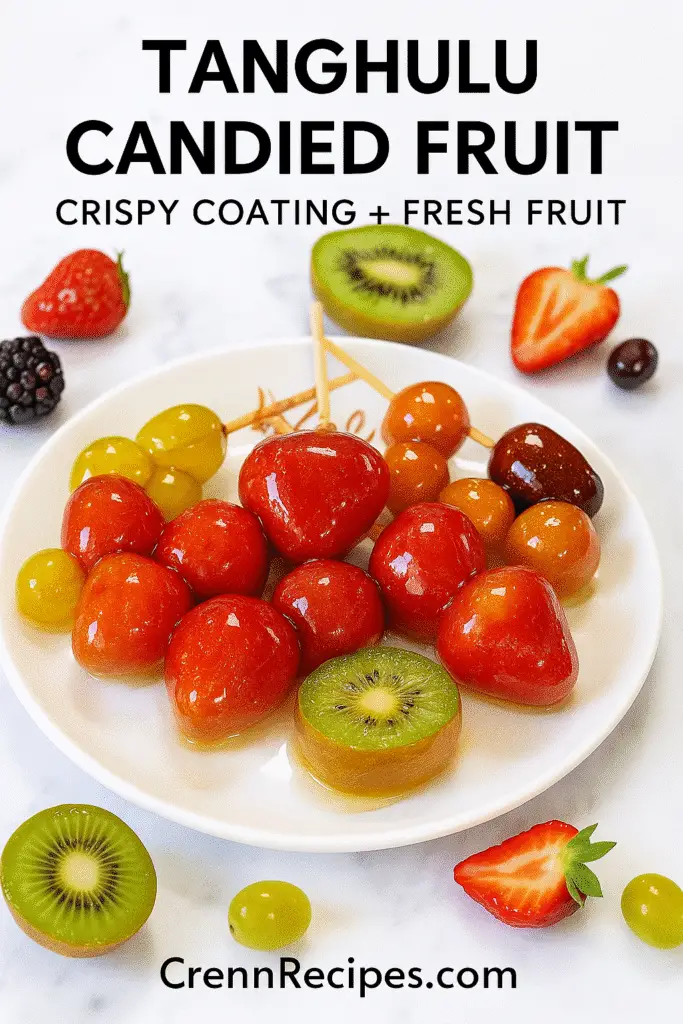
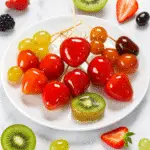
Tanghulu Candied Fruit: Ultimate Chinese Street Food Recipe Guide
- Total Time: 15
- Yield: 10 or more 1x
Description
Learn how to make tanghulu at home – a Chinese candied fruit snack with a crunchy, sweet shell. Use my simple and easy recipe, along with my top tips and video tutorial, to coat strawberries, grapes, or your favorite fruit!
Ingredients
1 lb strawberries AND/OR blueberries, grapes, kiwi, or other fruit of choice 2 cups white sugar 1 cup water
Instructions
Wash and pat dry the fruit well with a paper towel. Get the fruit ready. Remove the green stems of the strawberries. Remove grapes from their stems. Cut larger fruit like kiwi into slices or smaller bite-sized pieces. Arrange the fruit on the skewers—it’s best to thread just 1 or 2 pieces of fruit (depending on their size) and keep them at one end of the skewer. Set the skewers aside. Fill a bowl with cold water and add a few ice cubes to make an ice bath. Add the sugar and water to a medium-sized saucepan and bring them to a boil over medium heat. Do not stir! The temperature of the sugar syrup has to reach around 300ºF/150ºC. This takes 5-10 minutes. The syrup will start to reduce and become amber in color. Check the temperature occasionally with a thermometer (it’s OK if it’s a few degrees higher). Alternatively, drizzle some syrup into the bowl of ice water. It should set right away and form brittle crystal threads that break easily. If they bend, the syrup is not ready. Once the sugar syrup has reached the required temperature, remove the pot from the heat. You can prop the pot at an angle so it’s easier to dip the skewers in the deep part. Prepare your working station: skewered fruit, the syrup next to them, the ice bath, and a wire rack or a tray covered with parchment paper on which to lay the candied fruit. Take one of the skewers and quickly dip it in the mixture, making sure all the fruit is coated in the sugar syrup. Immediately dip it in the ice water and lay it on the tray. Repeat the steps of quickly dipping the skewered fruit in the syrup and ice water until all the fruit is done. Let them rest for a few minutes on the tray. Your tanghulu is now ready to enjoy!
Notes
Fruit options: Choose fruit with a firm texture, sour or tangy flavor, and juicy inside, like strawberries, grapes, blueberries, kiwi slices, orange wedges, Hawthorn berries, kumquats, cherries, apples, tangerines, pineapple, or even cherry tomatoes. To store: This is best enjoyed right away. Leftovers can be stored in an airtight container at room temperature. Avoid using plastic wrap, and don’t refrigerate. Check the blog post for more tips.
- Prep Time: 5
- Cook Time: 10
- Category: Dessert, Snack
- Method: Candy Making
- Cuisine: Asian, Chinese
Nutrition
- Serving Size: 1
- Calories: 171
- Sugar: 43g
- Sodium: 2mg
- Fat: 0.3g
- Saturated Fat: 0.01g
- Unsaturated Fat: 0.1g
- Trans Fat: 0g
- Carbohydrates: 44g
- Fiber: 1g
- Protein: 0.3g
- Cholesterol: 0mg

